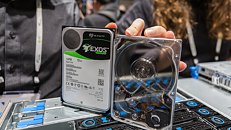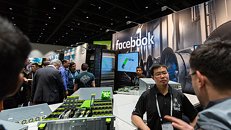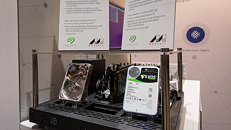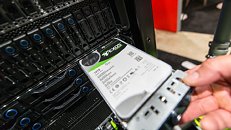Friday, August 3rd 2018

Seagate MACH.2 Multi Actuator Tech Enables 480MB/s HDDs
At the OCP summit this week Seagate and its partners revealed new proof points showing continued progress, solid results, and customer and industry adoption of the company's advanced HAMR and Multi Actuator technologies, which will be implemented in the near future in Seagate Exos enterprise hard drives.
Today Seagate said its new MACH.2 Multi Actuator technology has enabled them to set a new hard drive speed record, demonstrating up to 480MB/s sustained throughput - the fastest ever. Seagate formally introduced its MACH.2 Multi Actuator technology yesterday, which has now been deployed in development units for customer testing prior to productization. Read below to learn more.Seagate's advanced engineering team also announced a breakthrough in the demonstrated reliability of its HAMR (Heat-Assisted Magnetic Recording) technology hard drives. Seagate revealed that its HAMR read/write heads have achieved unprecedented results in long-term reliability tests that surpass customer requirements by a factor of 20. Continue below for more details.
Partners work with Seagate to prepare HAMR and Multi Actuator technology deployment
Seagate's technology team reports at OCP that partners have begun integration development with both our HAMR and our MACH.2 Multi Actuator technologies. Several partners displayed these advanced technologies, the new Seagate Exos X14 drive, and Seagate Nytro Data Center NVMe SSD Series drives in their booth demos.
"MACH.2 Multi Actuator technology is an IOPS-per-Terabyte win for Seagate and for our cloud provider partners," said Tony Glavis, Seagate marketing initiative manager for Enterprise applications, discussing the collaboration with Microsoft. "Our purpose is to accelerate technology innovation for performance in the cost-sensitive storage tier - and MACH.2 does that by solving response time for the end user and enabling our cloud partners to attain SLA requirements. Continued advances in capacity with HAMR and increased IOPS with MACH.2 work together to improved cost efficiencies while sustaining performance."
MACH.2 Multi Actuator sets hard drive speed record
Seagate engineers have set a new record for how fast data can stream data off of a hard drive. With a Seagate hard drive equipped with its MACH.2 Multi Actuator technology, Seagate has demonstrated up to 480MB/s sustained throughput - the fastest ever from a single hard drive, and 60 percent faster than a 15K drive.
Seagate MACH.2 Multi Actuator technology doubles IOPS performance in a single hard drive by using two independent actuators that can transfer data to the host computer concurrently.
As higher areal densities on future hard drives put downward pressure on performance, Seagate's MACH.2 Multi Actuator technology will more than offset these pressures. That means customers with data-intensive applications will continue to enjoy the highest levels of hard drive performance, while they simultaneously keep up with the need to manage vast, ever-increasing quantities of data.
MACH.2 solves the need for increased performance by enabling parallelism of data flows in and out of a single hard drive. By enabling the data center host computer to request and receive data from two areas of the drive in parallel, simultaneously, MACH.2 doubles the IOPS performance of each individual hard drive, more than offsetting any issues of reduced data availability that would otherwise arise with higher capacities.
Seagate HAMR technology far exceeds customer reliability requirements
Today Seagate's engineering team revealed in its latest in-lab reliability testing, Seagate HAMR read/write heads have far exceeded industry standards, surpassing customer requirements by a factor of 20.
The industry's standard specification for nearline hard drive reliability anticipates that a drive will be able to transfer 550TB per year, or 2750TB total over a five-year period. On a hard drive with 18 read/write heads, each head is expected to transfer 152TB reliably over five years.
Seagate's development team has now demonstrated a single HAMR read/write head transferring data for 6000 hours reliably, equaling 3.2 Petabytes of data transferred on a single head. That's more than 20 times the amount of data required by the spec.
How does this translate to a HAMR drive deployed in a data center?
"On any hard drive meeting the industry specification, if all heads on the drive were writing 100 percent of the time in the field - which, of course, they do not - that would mean each head had written 152TB per head in total," explained Jason Feist, Seagate's director of Enterprise Product Planning. "Or to put it into Petabytes: the customer requirement is that a single head can write 0.152 Petabytes; we're already writing 3.2 Petabytes on a single HAMR head."
Together, Seagate HAMR and MACH.2 Multi Actuator technologies maximize drive capacity while maintaining performance levels above data center customers' specifications.
Why do we pursue these Advanced Technologies?
Imagine your entire datasphere - all the data that enables you to thrive, succeed, connect, remember and cherish those around you; now imagine you had to slice away 90 percent of all your data. Imagine a future world in which we can only preserve ten percent of our memories, ten percent of our knowledge, ten percent of our software applications. If you imagine all your data represented as a photograph, that photograph becomes a low-resolution, grainy, greyscale image at best.
That's the near future we'd face, without the combined advances of higher capacities made possible by HAMR and the fast access to this enormous data pool made possible by Seagate MACH.2 Multi Actuator technology.
Feist noted that HAMR and MACH.2 are just the latest crucial advances made by our scientists and engineers, part of Seagate's long history developing breakthrough enabling technologies.
"Our story does not end here," he said. "But what we do here sets up what we can give to the future. A world where history is more than a grainy shadow. And we're working with our partners to help us create and achieve this vision, together."
Seagate's HAMR and MACH.2 Multi Actuator technologies are on track to work together, enabling new-generation capacities and performance. These technologies are being implemented in the near future in Seagate Exos enterprise hard drives.
Today Seagate said its new MACH.2 Multi Actuator technology has enabled them to set a new hard drive speed record, demonstrating up to 480MB/s sustained throughput - the fastest ever. Seagate formally introduced its MACH.2 Multi Actuator technology yesterday, which has now been deployed in development units for customer testing prior to productization. Read below to learn more.Seagate's advanced engineering team also announced a breakthrough in the demonstrated reliability of its HAMR (Heat-Assisted Magnetic Recording) technology hard drives. Seagate revealed that its HAMR read/write heads have achieved unprecedented results in long-term reliability tests that surpass customer requirements by a factor of 20. Continue below for more details.
Partners work with Seagate to prepare HAMR and Multi Actuator technology deployment
Seagate's technology team reports at OCP that partners have begun integration development with both our HAMR and our MACH.2 Multi Actuator technologies. Several partners displayed these advanced technologies, the new Seagate Exos X14 drive, and Seagate Nytro Data Center NVMe SSD Series drives in their booth demos.
"MACH.2 Multi Actuator technology is an IOPS-per-Terabyte win for Seagate and for our cloud provider partners," said Tony Glavis, Seagate marketing initiative manager for Enterprise applications, discussing the collaboration with Microsoft. "Our purpose is to accelerate technology innovation for performance in the cost-sensitive storage tier - and MACH.2 does that by solving response time for the end user and enabling our cloud partners to attain SLA requirements. Continued advances in capacity with HAMR and increased IOPS with MACH.2 work together to improved cost efficiencies while sustaining performance."
MACH.2 Multi Actuator sets hard drive speed record
Seagate engineers have set a new record for how fast data can stream data off of a hard drive. With a Seagate hard drive equipped with its MACH.2 Multi Actuator technology, Seagate has demonstrated up to 480MB/s sustained throughput - the fastest ever from a single hard drive, and 60 percent faster than a 15K drive.
Seagate MACH.2 Multi Actuator technology doubles IOPS performance in a single hard drive by using two independent actuators that can transfer data to the host computer concurrently.
As higher areal densities on future hard drives put downward pressure on performance, Seagate's MACH.2 Multi Actuator technology will more than offset these pressures. That means customers with data-intensive applications will continue to enjoy the highest levels of hard drive performance, while they simultaneously keep up with the need to manage vast, ever-increasing quantities of data.
MACH.2 solves the need for increased performance by enabling parallelism of data flows in and out of a single hard drive. By enabling the data center host computer to request and receive data from two areas of the drive in parallel, simultaneously, MACH.2 doubles the IOPS performance of each individual hard drive, more than offsetting any issues of reduced data availability that would otherwise arise with higher capacities.
Seagate HAMR technology far exceeds customer reliability requirements
Today Seagate's engineering team revealed in its latest in-lab reliability testing, Seagate HAMR read/write heads have far exceeded industry standards, surpassing customer requirements by a factor of 20.
The industry's standard specification for nearline hard drive reliability anticipates that a drive will be able to transfer 550TB per year, or 2750TB total over a five-year period. On a hard drive with 18 read/write heads, each head is expected to transfer 152TB reliably over five years.
Seagate's development team has now demonstrated a single HAMR read/write head transferring data for 6000 hours reliably, equaling 3.2 Petabytes of data transferred on a single head. That's more than 20 times the amount of data required by the spec.
How does this translate to a HAMR drive deployed in a data center?
"On any hard drive meeting the industry specification, if all heads on the drive were writing 100 percent of the time in the field - which, of course, they do not - that would mean each head had written 152TB per head in total," explained Jason Feist, Seagate's director of Enterprise Product Planning. "Or to put it into Petabytes: the customer requirement is that a single head can write 0.152 Petabytes; we're already writing 3.2 Petabytes on a single HAMR head."
Together, Seagate HAMR and MACH.2 Multi Actuator technologies maximize drive capacity while maintaining performance levels above data center customers' specifications.
Why do we pursue these Advanced Technologies?
Imagine your entire datasphere - all the data that enables you to thrive, succeed, connect, remember and cherish those around you; now imagine you had to slice away 90 percent of all your data. Imagine a future world in which we can only preserve ten percent of our memories, ten percent of our knowledge, ten percent of our software applications. If you imagine all your data represented as a photograph, that photograph becomes a low-resolution, grainy, greyscale image at best.
That's the near future we'd face, without the combined advances of higher capacities made possible by HAMR and the fast access to this enormous data pool made possible by Seagate MACH.2 Multi Actuator technology.
Feist noted that HAMR and MACH.2 are just the latest crucial advances made by our scientists and engineers, part of Seagate's long history developing breakthrough enabling technologies.
"Our story does not end here," he said. "But what we do here sets up what we can give to the future. A world where history is more than a grainy shadow. And we're working with our partners to help us create and achieve this vision, together."
Seagate's HAMR and MACH.2 Multi Actuator technologies are on track to work together, enabling new-generation capacities and performance. These technologies are being implemented in the near future in Seagate Exos enterprise hard drives.




39 Comments on Seagate MACH.2 Multi Actuator Tech Enables 480MB/s HDDs
How fast was the drive spinning, and what's the latency?
But they can still not compete with ssd in access time and responsness.
I think only BackBlaze, Google & Amazon for cloud storage is going to care about getting the absolute most TB per $ to be cut throat pricing wise. I think it's much easier trying to increase density per rack unit with 2.5" QLC SATA drives than large 3.5" HDDs. I think most companies will be going towards reducing the amount of rack chassis while increasing density per chassis. Hopefully that'll benefit us. I can see first gen 1TB QLC SATA SSD being $100 at least; still a premium but not extreme. Then going down after that. Plus discount on bulk orders since $100-ish would be MSRP on Amazon/Newegg. Just rough estimating.
With only PR and no whitepapers around, I'm thinking more like two drives in JBOD.
-Will grandma be able to open her grandkids pics receives from their mother this morning ?
-Will the legal secretary be able to type an extra legal brief before 5 o'clock ?
-Will the CAD operator be able to draft up and extra room in some dudes mansion ?
-Will the stock broker have up to date info available to him any faster ?
-Will a gamer be able to reach an further save point before bedtime ?
For others ...
-Will it eliminate the need for a large SSD scratch disk for video editing ?
-What is the impact on rendering boxes ?